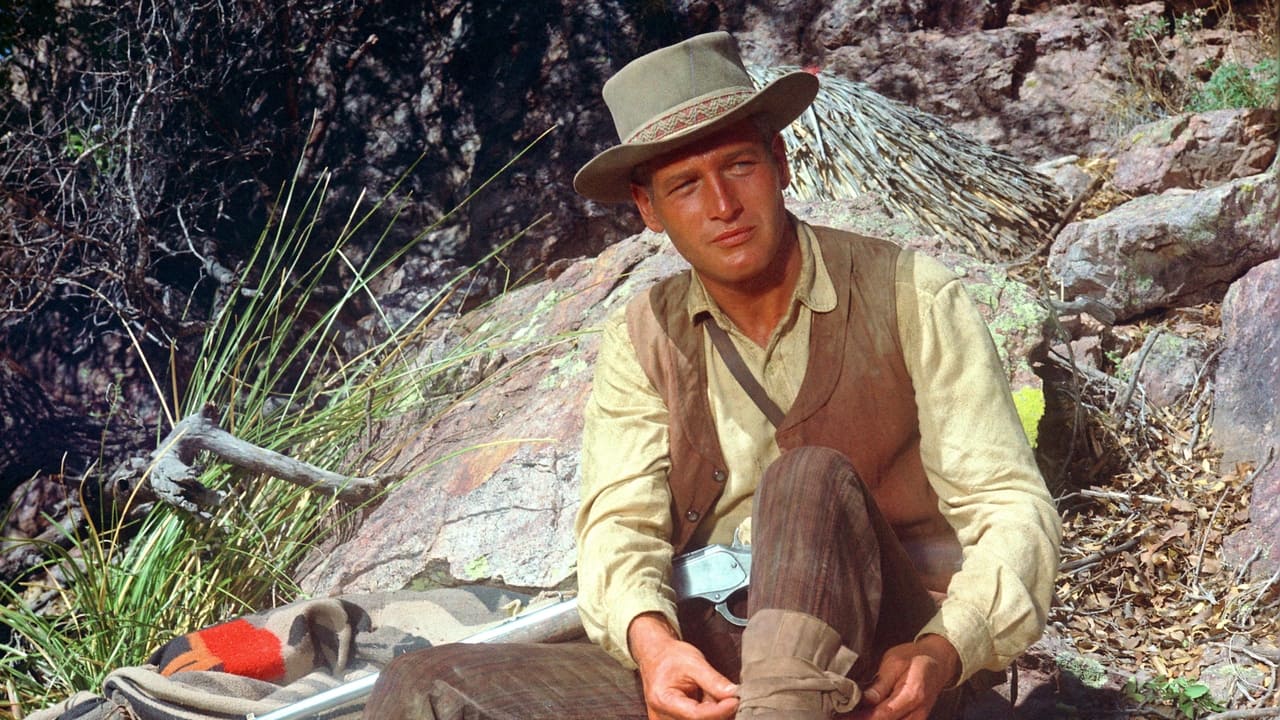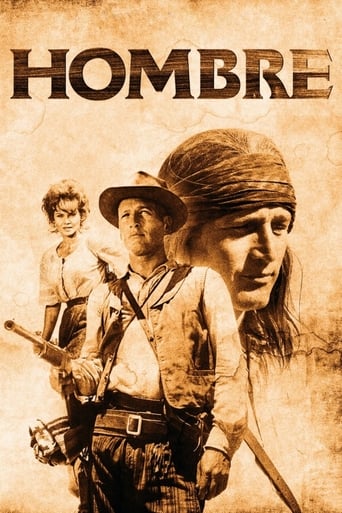

Like everyone else has said, this is an outstanding movie. I'm not going to attempt to rehash what's been said before, most of the preceding evaluations have been excellent. Just wanted to say that my favorites in this film were Paul Newman (of course) and Frank Silvera, who played the Mexican bandit (but was not a Mexican in real life). AND, my favorite line was mumbled by Diane Cilento (Sean Connery's 1st wife) just before the final show-down as she acknowledges that the evil Cicero Grimes (Richard Boone) has met his match, and worse, in John Russell (Paul Newman).All but one of the players in this film are no longer with us, several left more than 20 years ago.
... View MoreJust a few observations on the source and themes of this classic film that I haven't seen mentioned here. The source novel, or novella, really, at 99 pages, differs from the film in its collection and details of characters. Elmore Leonard's John Russell is about twenty- one years old. Newman was forty-one at the time - this required some changes to the plot and characters. The passengers in Leonard's story feature an eighteen-year-old white girl who has recently been freed from the Apaches after being held for a few weeks. She had to be changed into Diane Cilento's character. Russell's attraction in the novel doesn't become obvious until the climax. The novel is narrated by the kid, who is unmarried and leaving on the stage to seek his fortune in the world. Thus the screenwriters set the stage for a new thread of dialog during the trip around the nature of civilized relations between the sexes vs. that of the Indians. This not only replaces the brief discussion of the young girl's experience but provides padding for the longer form of the movie. It does seem out of place in this story, however, as a distraction from the buildup of suspense. But it is almost a requirement for Westerns from this period. The bad guys in the novel featured both cowboys from Delgado's bar, including the one who got his nose broke. The film, for some reason, substitutes Cameron Mitchell's bad sheriff for one of them, and this only reduces the suspense of whether Russell will be recognized, the irony of which is a central point to the plot. So, if Ford's 1939 movie makes the point that Ringo Kids are sometimes necessary in times of war, Elmore Leonard offers a more nuanced take on whether the good guys are all that good, and where virtue might be found.
... View MorePaul Newman reunites with "Hud" director Martin Ritt for this stark western. Newman plays John 'Hombre' Russell, a white man raised by Apaches who is shunned by the community as a result. When he inherits a boarding house in town, he decides to trade it for a herd, and must take a stagecoach to complete the deal. With him on the journey are Favor(Frederic March) and his wife Audra(played by Barbara Rush) a snobbish couple, along with ruthless gunfighter Grimes(played by Richard Boone) The trip is rudely interrupted by bandits, who force the passengers to flee into the mountains for safety, but with the bandits in pursuit, leaving Russell the only man to protect them... Interesting tale of prejudice and irony is quite cynical, with a familiar plot, yet works very well because of fine acting and direction.
... View More"The Indians must conform to 'the white man's ways', peaceably if they will, forcibly if they must. They must adjust themselves to their environment, and conform their mode of living substantially to our civilisation. This civilisation may not be the best possible, but it is the best the Indians can get. They cannot escape it, and must either conform to it or be crushed by it. The tribal relations should be broken up, socialism destroyed, and the family and the autonomy of the individual substituted." - Commissioner Thomas Morgan Director Martin Ritt and actor Paul Newman made several films together. One of their best was "Hombre", a 1967 revisionist western. The film's a masterpiece of the genre, but receives little notice today.The plot? Newman plays John Russell, an Apache-raised white man living in 19th century Arizona. When his father dies, Russell learns that he has inherited a house and land in the town of Bisbee. The film's first act thus watches as Russell – essentially emblematic of persecuted Native Americans – journeys out of the wilderness, sets upon his new home and struggles to acclimatize to both modernity and western civilisation.The film's second act then leaps off into another director. Here Ritt introduces us to a number of wildly divergent characters. Foremost amongst these is Jessie (Diane Cilento), a middle aged woman who struggles to survive in the Arizonan deserts. Hardened by time, she's a unique mixture of self-sufficiency and neediness. Like the other two women in the film – one wealthy, one a pauper, both sexually dissatisfied – she's also been repeatedly burnt by men. Mirrored to the three women are men in positions of power. One's a soldier, one's a sheriff, one's a professor in charge of taking care of Indian Reservations (essentially concentration camps in which Native Indians were housed). Each character betrays his position of authority and reveals himself to be a corrupt, selfish brute. By the film's end, the only positive male roles will be assigned to a Mexican man, Henry Mendez, and Newman's John Russell, both marginalized or minorities.The film's third act then essentially becomes an existential morality play. Here the film's title, which means "man" in Spanish, alludes to mankind in a more generalised, philosophical sense. In Ritt's hands, all men, and indeed all civilisational institutions, are seen to be inherently corrupt. Because we view the world through John Russell's eyes, a man who has been persecuted all his life and who has learnt to both keep his distance and view others with apathy and scorn, Ritt's nihilistic stance is seductive. This easy seduction is questioned, though, during the film's highly abstract final sequences, in which community, altruism and self-sacrifice are positioned on one hand, and ego, individualism, apathy and selfishness are positioned on the other. Various characters are asked to jump from one extreme to the next, but it's only John Russell who makes the leap, risking his life to save men and women who'd readily watch others rot if it made them a buck.What's odd about "Hombre" is how much it says about the treatment of Native American Indians without actually being about Native American Indians. The film's racism is mostly alluded to and treated as unspoken, psychic ripples. Elsewhere there are possible allusions to then contemporary civil rights issues (Russell excluded to the top of a stagecoach, like African Americans shunted to the backs of buses), and it is hinted that it's not Russell who has come to civilisation, but he who brings civilisation to Arizona; he who shows "them" how to act like a "man", and "they" who must learn to conform to him.One must remember that Ritt was once a radical leftist who had loose affiliations with various communist or left-leaning movements, a fact which got him blacklisted during the Hollywood's horrible Witchhunt Years. Ritt's films can themselves be divided into loose groups. One group tends to be preoccupied with watching as characters, who represent the modern ethos of capitalism, come into contact with their opposites ("Hud", "Hombre" etc). Another group focuses on the lives of the marginalized, often African Americans who struggle with various socio-economic problems ("Sounder", "Conrack", "The Great White Hope" etc). Yet another chunk of Ritt's films tend to deal with groups or organisations being infiltrated and undermined by the literal or figurative foot-soldiers of either communism or capitalism ("Norma Rae", "The Spy Who Came In From The Cold", "The Molly Maguires"). "Hombre" belongs to the first group, but Newman's character is also very much like the spies of "Cold", "Molly" and "Norma Rae", infiltrating groups and changing them from within."Hombre" was shot in Death Valley and around the Halvetia Mines. It features some fine photography by James Wong Howe, director Martin Ritt's camera work is simple but classy, Richard Boone impresses as a craggy villain, and the film, quite interestingly, moves from melodrama to abstract, philosophical ordeal, its characters slowly dying, dehydrating and climbing absurd stairs seemingly torn out of the Myth of Sisyphus. Unsurprisingly for a film derived from a book by Elmore Leonard, the film's dialogue offers a kind of blunt poetry.Incidentally, this period saw a number of excellent revisionist westerns ("Sitting Bull", "McCabe", "Bad Company", "Soldier Blue", "Little Big Man", "The Great Northfield Minnesota Raid", "Broken Lance", "Hud" etc). Most of these films are overlooked when discussions on Westerns arise. Those westerns which are praised, in contrast, tend to merely be giant allegories for the passing of an era and its assorted totems. Nostalgic (and oft reactionary) films which pine for a specific type of outlaw masculinity, most of these Westerns are thin (Leone, Ford, Peckinpah etc), using steam-engines, railways, machine guns, or blaze of glory bloodbaths as clunky "metaphors" for what is essentially the death of a false image.8.9/10 – A strong Western, marred only by silly early scenes featuring Newman in a wig. Worth two viewings.
... View More